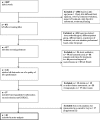The impact of malocclusions on oral health-related quality of life in children-a systematic review and meta-analysis
- PMID: 26635095
- PMCID: PMC5069349
- DOI: 10.1007/s00784-015-1681-3
The impact of malocclusions on oral health-related quality of life in children-a systematic review and meta-analysis
Abstract
Introduction: A limited amount of systematic literature reviews on the association between malocclusions and oral health-related quality of life (OHRQOL) summarize inconclusive results. Therefore, we conduct a systematic review and meta-analysis on the association of malocclusions with OHRQOL in children.
Methods: Relevant studies were identified in Pubmed, Embase, Cochrane, Google Scholar and other databases. All studies with data on malocclusions or orthodontic treatment need and OHRQOL in children were included. Methodological quality of the studies was assessed with the Newcastle-Ottawa Scale (NOS). Random effects models were used to estimate summary effect measures for the association between malocclusion and OHRQOL in a continuous and a categorical data analysis. Tests for heterogeneity, publication bias and sensitivity of results were performed.
Results: In total, 40 cross-sectional studies were included in the meta-analyses. Summary measures of the continuous data show that OHRQOL was significantly lowered in children with malocclusions (standardized mean difference (95 % CI] = 0.29 (0.19-0.38)). The summary odds ratio for having an impact on OHRQOL was 1.74 times higher in children with malocclusion than in children without malocclusions. Heterogeneity among studies was partly explained by malocclusion assessment, age of the children and country of study conduction.
Conclusion: Our results provide evidence for a clear inverse association of malocclusion with OHRQOL. We also showed that the strength of the association differed depending on the age of the children and their cultural environment.
Clinical relevance: Dentists benefit from understanding the patient differences regarding the impact of malocclusions.
Keywords: Children; Malocclusions; Meta- analysis; Quality of life.
Conflict of interest statement
Compliance with ethical standards This article does not contain any studies with human participants or animals performed by any of the authors. The work was supported by the Department of Oral & Maxillofacial Surgery, Special Dental Care and Orthodontics of Erasmus Medical Center in Rotterdam, the Netherlands. Conflict of interest The authors declare that they have no competing interests.
Figures



References
-
- Schuller AA, van Kempen IPF, Poorterman JHG, Verrips GHW. Kies voor Tanden. Een onderzoek naar mondgezondheid en preventief tandheelkundig gedrag van jeugdigen, Hoofdmeeting 2011. The Netherlands: Academisch Tandheelcentrum Amsterdam (ACTA); 2013.
-
- Liu Z, McGrath C, Hägg U. The impact of malocclusion/orthodontic treatment need on the quality of life. Angle Orthod. 2009;79:585–591. - PubMed
Publication types
MeSH terms
LinkOut - more resources
Full Text Sources
Other Literature Sources
Medical

